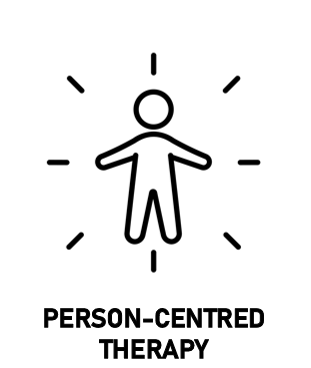Person-centred Therapy is a type of talking therapy that can be used for a range of mental health conditions. The person is front and centre of this therapy.
There is an aim of improving the patient’s attitude towards growth and fulfilment. This is referred to as “self-actualisation” in the context of Person-centred Therapy.

How Does Person-centred Therapy Work?
American Psychotherapist Carl Rogers developed Person-centred Therapy in the 1940s [1]. He built on the therapy in the following decades, and it subsequently became very well-known.
The overarching belief is that humans have an innate tendency to fulfil their potential. However, this is sometimes not possible due to various events or experiences – which cause mental illness.
Rogers believed that under the right circumstances, a person is able to reach self-actualisation – where they become their true self, grow as a person and have a fulfilling life.
There are three main pillars of Person-centred Therapy:
- Unconditional positive regard: The patient is urged to accept and value themselves
- Congruence: The therapist will let the patient know how they experience them
- Empathetic Understanding: The therapist sees the viewpoint of the patient, as if they were the patient
These three pillars help to support the overall goal of Person-centred Therapy. There is a strong focus on the therapist-patient relationship.
When is Person-centred Therapy Useful?
Person-centred Therapy can be useful for some people. It is mainly effective for those who have a lack of self-esteem or personality problems.
Therefore, many people with Depression may find value in this type of therapy, as well as anyone with a Personality Disorder.
Anyone that has gone through a difficult experience – or had their journey to fulfilling their potential stunted – could also benefit from this form of therapy.
But Person-centred Therapy doesn’t align itself with a specific condition, but more for those that believe the approach that this therapy offers will suit them.
Advantages of Person-centred Therapy
There are a few advantages to Person-centred Therapy:
- Person-centred Therapy puts the full focus on the patient. They will be pushed to fulfil their potential, made to value themselves and improve their relationships – all positive mental steps
- A major part of Person-centred Therapy is for the therapist to accept the patient’s behaviours, actions and feelings without judgment or disapproval. They can help the person see other perspectives though, which can be helpful.
- Person-centred Therapy is a type of talking therapy that emphasises the importance of the patient being able to speak their mind. Therefore, this gives the patient the chance to discuss what they are feeling, explore areas about themselves that they want to, and decide themselves when they believe they no longer need treatment.
Disadvantages of Person-centred Therapy
There are a few disadvantages to Person-centred Therapy:
- For Person-centred Therapy to work successfully, there is a strong focus on the patient and therapist getting along strongly. If the duo fail to “click” as a pair, it will be difficult to get positive results.
- The unstructured nature of Person-centred Therapy means that it can take a while for the patient to see improvements. If they are in desperate need of rapid improvements, Person-centred Therapy may not be effective for them.
- Person-centred Therapy involves the patient actively leading the sessions. For those that want the therapist to take charge more, Person-centred Therapy may not be suitable for them. Rogers even described the approach as “non-directive therapy”.
How effective is Person-centred Therapy?
Due to the broad range of applications of Person-centred Therapy, there isn’t too much research into overall findings. But many people do find Person-centred Therapy to be effective.
The idea behind Person-centred Therapy has been praised as offering something “with new developments in thinking and practice”, as well as “innovative” [2]. It certainly offers something different.
Person-centred Therapy can certainly help to improve self-esteem and feelings of a lack of identity. One study found that Person-centred Therapy improved cases of Social Anxiety [3].
Ultimately, every person will have a slightly different way in which they get the most out of therapy. For some, this will be a person-centred approach, whilst others will want something else. There are a range of other talking therapies if needed.
How to find a therapist?
It is recommended that you contact your GP and inform them of your problems. They will refer you to the relevant mental health team.
If you are aiming to use the private sector, you could ask your GP or someone you know for a recommendation. You can also look online – the British Association for Counselling and Psychotherapy have a therapist directory on their site.
See Also
- List of Therapy Types
- Therapy Home
- Everything You Need To Know About Talking Therapy
- Talking Therapy or Medication: Which is Better for Mental Health Problems?
- FAQ’s About Talking Therapy
- What To Do When Therapy Isn’t Working: Alternatives to Talking Therapy
Alternatives
If talking therapy alone hasn’t worked, then your Doctor may suggest adding a medication.
There are many other types of therapy, you can see an exhaustive list of them here.
Disclaimer
This website should be used purely for informational purposes, and does not intend to, nor should it ever, be used as a replacement for professional medical advice.
We strive to keep all of our pages updated, and ensure that our website is full of factual and in-depth information. However, we encourage you to browse this website with care.
As a reminder, this website and all content within it cannot and should not replace the advice of a trained medical professional. You can read our full disclaimer at this link.
Helplines
If you are struggling with your mental health, help is available. With the right support and treatment, you can make a recovery. For information on helplines, or if you are in a state of crisis, please visit our crisis page by clicking on the relevant link for your geographical location (United Kingdom), (United States), (International). You can also see how to get mental health treatment and the process involved by clicking this link.
References
[1] Rogers, C. R. (1942). Counseling and psychotherapy. Cambridge, MA: Riverside Press.
[2] Cooper, M. (2007). Person-centred therapy: the growing edge. Therapy Today. 7: p33-36.
[3] Stephen, S., Elliott, R., & Macleod, R. (2011). Person-centred therapy with a client experiencing social anxiety difficulties: A hermeneutic single case efficacy design. Behavioral Sciences Journals. 11 (1): p55-66.



































